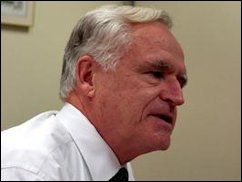by James A. Bacon
Last Wednesday Richard Sarles, chief executive officer of the Washington Metropolitan Area Transit Authority (WMATA), appeared in Richmond to brief the Commonwealth Transportation Board (CTB) on the transit authority’s plans to meet the transportation needs of the fast-growing Washington region, including Northern Virginia, through 2025.
Sarles did not provide a specific figure that WMATA will be asking of Virginia and the localities served by the Metro and bus lines but he indicated that system-wide, the Momentum plan calls for boosting capital spending by $400 million to $500 million yearly above the $900 million a year it already spends. That sum would be divvied up between Maryland, Washington, D.C., and the federal government.
The pitch was pure economic development. “We’ve looked at what we need to do to provide for growth over the next 15 to 20 years — it’s the equivalent of the City of Houston moving to the region,” Sarles said. “If we did nothing, the area would become so congested that economic development would stagnate.”
In his presentation, Sarles focused mainly on plans to upgrade the length of Metro trains to eight, the longest possible, by acquiring additional cars, power capacity and rail car storage. That one initiative would allow the system to carry 35,000 more passengers per hour during rush hour — the equivalent, he said, of building 18 new lanes of highways into the district.
The presentation was purely informational, to acquaint the CTB with WMATA’s plans and the need for state support. In separate remarks to the CTB, Jennifer Mitchell, director of Virginia’s Department of Rail and Public Transit, said the state already contributes $50 million a year to WMATA’s program to bring the aging and problem-plagued system to a condition of good repair. Additionally, Governor Terry McAuliffe has promised a $25 million down payment to the Momentum expansion program, matched by equal sums from Maryland and D.C. “The goal will be working on a long-term funding agreement defining the state’s long-term funding commitment.”
WMATA trains and buses take 1.2 million trips off the road each weekday, said Sarles, relieving local jurisdictions of the need to construct at least 1,000 lane-miles of road and tens of thousands of parking spaces. Without Metro, Virginia would have to spend $1.3 billion on roads and $358 million on parking, he said. (Editorial comment: The sum for roads seems way low — could that be $1.3 billion per year on roads?)
A WMATA handout summarized the key components of WMATA’s expansion plan:
- Eight-car trains. Expand the length of trains to eight cars, which will carry 35,000 more passengers per hour during rush hour.
- Upgraded rail stations. Expand high-volume rail transfer stations in the Metro system core to ease congestion and accommodate new riders. This will include building underground pedestrian connections between select stations such as Farragut and Metro Center/Gallery Place in D.C. so riders can walk between stations rather than transfer on trains.
- Priority corridor network (PCN). Completing the PCN will allow buses to bypass traffic congestion, moving 50% faster, saving passengers 3 to 4 minutes per trip and eliminating an additional 100,000 trips from roadways.
- Blue line service. Restore peak-period Blue Line service between the Pentagon and Rosslyn stations through the construction of underground tracks. Adding five more trains per hour during the peak period will provide capacity for at least 4,000 passenger per direction.
- Better information. Create one-stop information shopping so riders can plan, pay for and take transit trips seamlessly across the region. Also, stations will provide real-time travel information.
- Bus fleet. Expand the bus fleet and maintenance facilities, enabling an extra 40,000 bus trips per day. (Yes, the document says bus trips, not bus passengers. Presumably, each trip would carry multiple passengers.)
- New rail infrastructure. Build pocket tracks and crossovers to provide more flexibility to the system and respond to service disruptions. This investment could reduce operating costs to local jurisdictions.
Sarles provided no information about how much each component of the Momentum plan would cost, nor a Return on Investment analysis. CTB members did not ask for any such information. Instead, he made a general argument that without additional investment, increased population and economic growth would increase congestion on the system, leading to more delays and service disruptions. The crowding seen on Presidential Inauguration Day, stated Sarles’ handout, “could become the norm.” Residents would have fewer jobs within acceptable commuting distance, and employers would have access to a smaller pool of employees. “Lack of WMATA investment harms the region’s competitive advantage for talent, jobs and investment dollars.”
No mention was made of WMATA’s structural cost challenges due to union wages, benefits and featherbedding practices. Although Sarles noted that fares cover 75% of METRO’s operating costs, he made no mention of WMATA’s fare structure, which some have criticized as being too low. Congestion on the system suggests that WMATA has ample room to push rates higher and and reduce operating subsidies. But others have argued that higher fares would be devastating to the region’s poor, who are hard-pressed to pay the fares as it is. Finally, no mention was made of delays in opening the Silver Line service to Tysons. That service was scheduled to begin December but the communications system that allows trains to communication with Metro Control Center does not work correctly and needs to be replaced. That work could take months.



